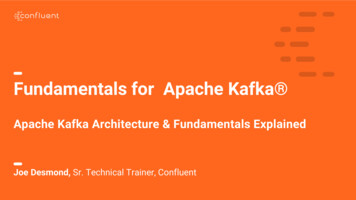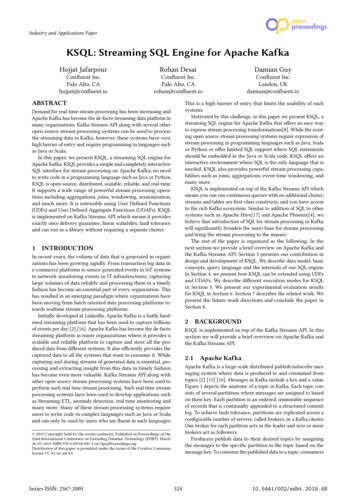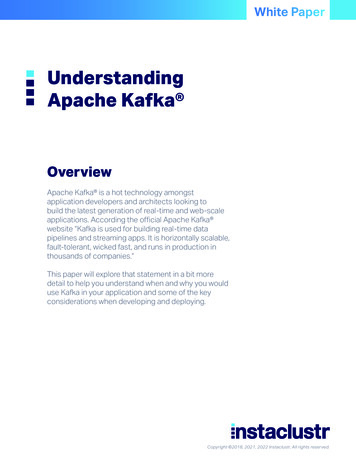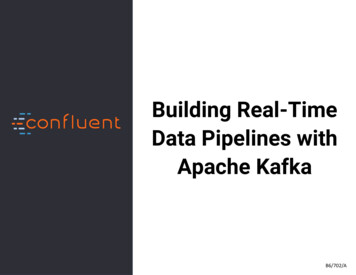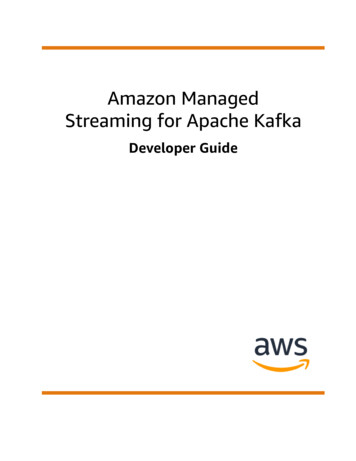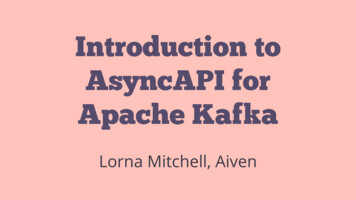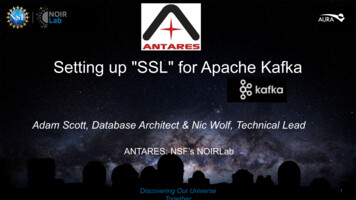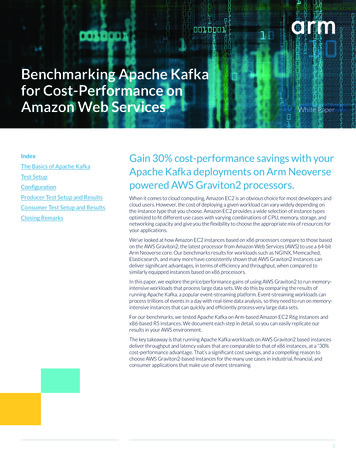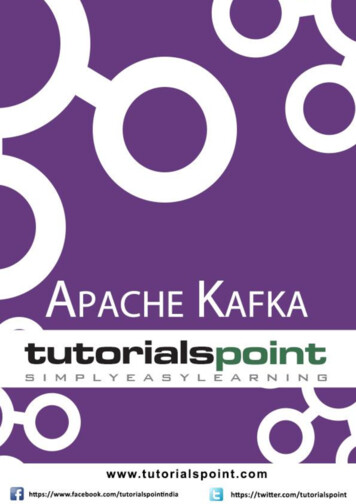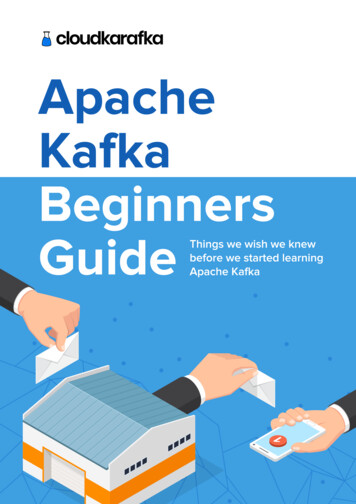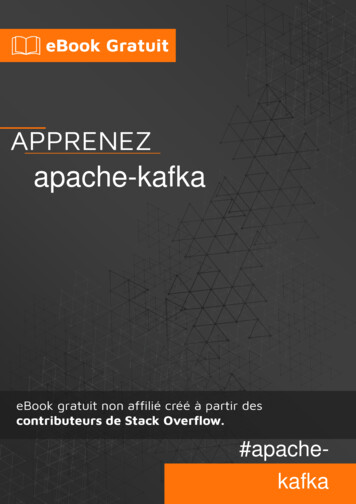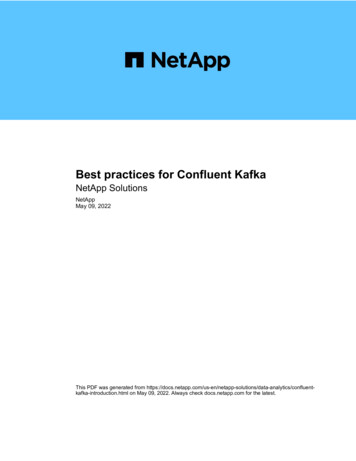
Transcription
Best practices for Confluent KafkaNetApp SolutionsNetAppMay 09, 2022This PDF was generated from a-analytics/confluentkafka-introduction.html on May 09, 2022. Always check docs.netapp.com for the latest.
Table of ContentsBest practices for Confluent Kafka . . . . . . . . . . . . . . . . . . . . . . . . . . . . . . . . . . . . . . . . . . . . . . . . . . . . . . . . . . . . 1TR-4912: Best practice guidelines for Confluent Kafka tiered storage with NetApp . . . . . . . . . . . . . . . . . . . . 1Solution architecture details . . . . . . . . . . . . . . . . . . . . . . . . . . . . . . . . . . . . . . . . . . . . . . . . . . . . . . . . . . . . . . . 3Technology overview . . . . . . . . . . . . . . . . . . . . . . . . . . . . . . . . . . . . . . . . . . . . . . . . . . . . . . . . . . . . . . . . . . . . 4Confluent verification . . . . . . . . . . . . . . . . . . . . . . . . . . . . . . . . . . . . . . . . . . . . . . . . . . . . . . . . . . . . . . . . . . . 10Performance tests with scalability . . . . . . . . . . . . . . . . . . . . . . . . . . . . . . . . . . . . . . . . . . . . . . . . . . . . . . . . . 13Confluent s3 connector . . . . . . . . . . . . . . . . . . . . . . . . . . . . . . . . . . . . . . . . . . . . . . . . . . . . . . . . . . . . . . . . . 15Confluent Self-balancing Clusters . . . . . . . . . . . . . . . . . . . . . . . . . . . . . . . . . . . . . . . . . . . . . . . . . . . . . . . . . 24Best practice guidelines . . . . . . . . . . . . . . . . . . . . . . . . . . . . . . . . . . . . . . . . . . . . . . . . . . . . . . . . . . . . . . . . . 24Sizing . . . . . . . . . . . . . . . . . . . . . . . . . . . . . . . . . . . . . . . . . . . . . . . . . . . . . . . . . . . . . . . . . . . . . . . . . . . . . . . 26Conclusion . . . . . . . . . . . . . . . . . . . . . . . . . . . . . . . . . . . . . . . . . . . . . . . . . . . . . . . . . . . . . . . . . . . . . . . . . . . 29
Best practices for Confluent KafkaTR-4912: Best practice guidelines for Confluent Kafka tieredstorage with NetAppKarthikeyan Nagalingam, Joseph Kandatilparambil, NetAppRankesh Kumar, ConfluentApache Kafka is a community-distributed event-streaming platform capable of handling trillions of events a day.Initially conceived as a messaging queue, Kafka is based on an abstraction of a distributed commit log. Since itwas created and open-sourced by LinkedIn in 2011, Kafka has evolved from a messages queue to a fullfledged event-streaming platform. Confluent delivers the distribution of Apache Kafka with the ConfluentPlatform. The Confluent Platform supplements Kafka with additional community and commercial featuresdesigned to enhance the streaming experience of both operators and developers in production at a massivescale.This document describes the best-practice guidelines for using Confluent Tiered Storage on a NetApp’s Objectstorage offering by providing the following content: Confluent verification with NetApp Object storage – NetApp StorageGRID Tiered storage performance tests Best-practice guidelines for Confluent on NetApp storage systemsWhy Confluent Tiered Storage?Confluent has become the default real-time streaming platform for many applications, especially for big data,analytics, and streaming workloads. Tiered Storage enables users to separate compute from storage in theConfluent platform. It makes storing data more cost effective, enables you to store virtually infinite amounts ofdata and scale workloads up (or down) on-demand, and makes administrative tasks like data and tenantrebalancing easier. S3 compatible storage systems can take advantage of all these capabilities to democratizedata with all events in one place, eliminating the need for complex data engineering. For more info on why youshould use tiered storage for Kafka, check this article by Confluent.Why NetApp StorageGRID for tiered storage?StorageGRID is an industry-leading object storage platform by NetApp. StorageGRID is a software-defined,object-based storage solution that supports industry-standard object APIs, including the Amazon SimpleStorage Service (S3) API. StorageGRID stores and manages unstructured data at scale to provide secure,durable object storage. Content is placed in the right location, at the right time, and on the right storage tier,optimizing workflows and reducing costs for globally distributed rich media.The greatest differentiator for StorageGRID is its Information Lifecycle Management (ILM) policy engine thatenables policy-driven data lifecycle management. The policy engine can use metadata to manage how data isstored across its lifetime to initially optimize for performance and automatically optimize for cost and durabilityas data ages.Enabling Confluent Tiered StorageThe basic idea of tiered storage is to separate the tasks of data storage from data processing. With thisseparation, it becomes much easier for the data storage tier and the data processing tier to scaleindependently.1
A tiered storage solution for Confluent must contend with two factors. First, it must work around or avoidcommon object store consistency and availability properties, such as inconsistencies in LIST operations andoccasional object unavailability. Secondly, it must correctly handle the interaction between tiered storage andKafka’s replication and fault tolerance model, including the possibility of zombie leaders continuing to tier offsetranges. NetApp Object storage provides both the consistent object availability and HA model make the tiredstorage available to tier offset ranges. NetApp object storage provides consistent object availability and an HAmodel to make the tired storage available to tier offset ranges.With tiered storage, you can use high-performance platforms for low-latency reads and writes near the tail ofyour streaming data, and you can also use cheaper, scalable object stores like NetApp StorageGRID for highthroughput historical reads. We also have technical solution for Spark with netapp storage controller anddetails are here. The following figure shows how Kafka fits into a real-time analytics pipeline.The following figure depicts how NetApp StorageGRID fits in as Confluent Kafka’s object storage tier.2
Next: Solution architecture details.Solution architecture detailsPrevious: Introduction.This section covers the hardware and software used for Confluent verification. This information is applicable toConfluent Platform deployment with NetApp storage. The following table covers the tested solution architectureand base components.Solution componentsConfluent Kafka version 6.2Details Three zookeepers Five broker servers Five tools servers One Grafana One control centerLinux (ubuntu 18.04)NetApp StorageGRID for tiered storageAll servers StorageGRID software 1 x SG1000 (load balancer) 4 x SGF6024 4 x 24 x 800 SSDs S3 protocol 4 x 100GbE (network connectivity between brokerand StorageGRID instances)3
Solution componentsDetails15 Fujitsu PRIMERGY RX2540 serversEach equipped with:* 2 CPUs, 16 physical cores total* Intel Xeon* 256GB physical memory* 100GbE dual portNext: Technology overview.Technology overviewPrevious: Solution architecture details.This section describes the technology used in this solution.NetApp StorageGRIDNetApp StorageGRID is a high-performance, cost-effective object storage platform. By using tiered storage,most of the data on Confluent Kafka, which is stored in local storage or the SAN storage of the broker, isoffloaded to the remote object store. This configuration results in significant operational improvements byreducing the time and cost to rebalance, expand, or shrink clusters or replace a failed broker. Object storageplays an important role in managing data that resides on the object store tier, which is why picking the rightobject storage is important.StorageGRID offers intelligent, policy-driven global data management using a distributed, node-based gridarchitecture. It simplifies the management of petabytes of unstructured data and billions of objects through itsubiquitous global object namespace combined with sophisticated data management features. Single-call objectaccess extends across sites and simplifies high availability architectures while ensuring continual objectaccess, regardless of site or infrastructure outages.Multitenancy allows multiple unstructured cloud and enterprise data applications to be securely serviced withinthe same grid, increasing the ROI and use cases for NetApp StorageGRID. You can create multiple servicelevels with metadata-driven object lifecycle policies, optimizing durability, protection, performance, and localityacross multiple geographies. Users can adjust data management policies and monitor and apply traffic limits torealign with the data landscape nondisruptively as their requirements change in ever-changing ITenvironments.Simple management with Grid ManagerThe StorageGRID Grid Manager is a browser-based graphical interface that allows you to configure, manage,and monitor your StorageGRID system across globally distributed locations in a single pane of glass.4
You can perform the following tasks with the StorageGRID Grid Manager interface: Manage globally distributed, petabyte-scale repositories of objects such as images, video, and records. Monitor grid nodes and services to ensure object availability. Manage the placement of object data over time using information lifecycle management (ILM) rules. Theserules govern what happens to an object’s data after it is ingested, how it is protected from loss, whereobject data is stored, and for how long. Monitor transactions, performance, and operations within the system.Information Lifecycle Management policiesStorageGRID has flexible data management policies that include keeping replica copies of your objects andusing EC (erasure coding) schemes like 2 1 and 4 2 (among others) to store your objects, depending onspecific performance and data protection requirements. As workloads and requirements change over time, it’scommon that ILM policies must change over time as well. Modifying ILM policies is a core feature, allowingStorageGRID customers to adapt to their ever-changing environment quickly and easily. Please check the ILMpolicy and ILM rules setup in StorageGRID.PerformanceStorageGRID scales performance by adding more storage nodes, which can be VMs, bare metal, or purposebuilt appliances like the SG5712, SG5760, SG6060, or SGF6024. In our tests, we exceeded the Apache Kafkakey performance requirements with a minimum-sized, three-node grid using the SGF6024 appliance. Ascustomers scale their Kafka cluster with additional brokers, they can add more storage nodes to increaseperformance and capacity.Load balancer and endpoint configurationAdmin nodes in StorageGRID provide the Grid Manager UI (user interface) and REST API endpoint to view,5
configure, and manage your StorageGRID system, as well as audit logs to track system activity. To provide ahighly available S3 endpoint for Confluent Kafka tiered storage, we implemented the StorageGRID loadbalancer, which runs as a service on admin nodes and gateway nodes. In addition, the load balancer alsomanages local traffic and talks to the GSLB (Global Server Load Balancing) to help with disaster recovery.To further enhance endpoint configuration, StorageGRID provides traffic classification policies built into theadmin node, lets you monitor your workload traffic, and applies various quality-of-service (QoS) limits to yourworkloads. Traffic classification policies are applied to endpoints on the StorageGRID Load Balancer servicefor gateway nodes and admin nodes. These policies can assist with traffic limiting and monitoring.Traffic classification in StorageGRIDStorageGRID has built-in QoS functionality. Traffic classification policies can help monitor different types of S3traffic coming from a client application. You can then create and apply policies to put limits on this traffic basedon in/out bandwidth, the number of read/write concurrent requests, or the read/write request rate.Apache KafkaApache Kafka is a framework implementation of a software bus using stream processing written in Java andScala. It’s aimed to provide a unified, high-throughput, low-latency platform for handling real-time data feeds.Kafka can connect to an external system for data export and import through Kafka Connect and provides Kafkastreams, a Java stream processing library. Kafka uses a binary, TCP-based protocol that is optimized forefficiency and relies on a "message set" abstraction that naturally groups messages together to reduce theoverhead of the network roundtrip. This enables larger sequential disk operations, larger network packets, andcontiguous memory blocks, thereby enabling Kafka to turn a bursty stream of random message writes intolinear writes. The following figure depicts the basic data flow of Apache Kafka.Kafka stores key-value messages that come from an arbitrary number of processes called producers. The datacan be partitioned into different partitions within different topics. Within a partition, messages are strictlyordered by their offsets (the position of a message within a partition) and indexed and stored together with atimestamp. Other processes called consumers can read messages from partitions. For stream processing,Kafka offers the Streams API that allows writing Java applications that consume data from Kafka and writeresults back to Kafka. Apache Kafka also works with external stream processing systems such as Apache6
Apex, Apache Flink, Apache Spark, Apache Storm, and Apache NiFi.Kafka runs on a cluster of one or more servers (called brokers), and the partitions of all topics are distributedacross the cluster nodes. Additionally, partitions are replicated to multiple brokers. This architecture allowsKafka to deliver massive streams of messages in a fault-tolerant fashion and has allowed it to replace some ofthe conventional messaging systems like Java Message Service (JMS), Advanced Message Queuing Protocol(AMQP), and so on. Since the 0.11.0.0 release, Kafka offers transactional writes, which provide exactly oncestream processing using the Streams API.Kafka supports two types of topics: regular and compacted. Regular topics can be configured with a retentiontime or a space bound. If there are records that are older than the specified retention time or if the spacebound is exceeded for a partition, Kafka is allowed to delete old data to free storage space. By default, topicsare configured with a retention time of 7 days, but it’s also possible to store data indefinitely. For compactedtopics, records don’t expire based on time or space bounds. Instead, Kafka treats later messages as updatesto older message with the same key and guarantees never to delete the latest message per key. Users candelete messages entirely by writing a so-called tombstone message with the null value for a specific key.There are five major APIs in Kafka: Producer API. Permits an application to publish streams of records. Consumer API. Permits an application to subscribe to topics and processes streams of records. Connector API. Executes the reusable producer and consumer APIs that can link the topics to the existingapplications. Streams API. This API converts the input streams to output and produces the result. Admin API. Used to manage Kafka topics, brokers and other Kafka objects.The consumer and producer APIs build on top of the Kafka messaging protocol and offer a referenceimplementation for Kafka consumer and producer clients in Java. The underlying messaging protocol is abinary protocol that developers can use to write their own consumer or producer clients in any programminglanguage. This unlocks Kafka from the Java Virtual Machine (JVM) ecosystem. A list of available non-Javaclients is maintained in the Apache Kafka wiki.Apache Kafka use casesApache Kafka is most popular for messaging, website activity tracking, metrics, log aggregation, streamprocessing, event sourcing, and commit logging. Kafka has improved throughput, built-in partitioning, replication, and fault-tolerance, which makes it a goodsolution for large-scale message-processing applications. Kafka can rebuild a user’s activities (page views, searches) in a tracking pipeline as a set of real-timepublish-subscribe feeds. Kafka is often used for operational monitoring data. This involves aggregating statistics from distributedapplications to produce centralized feeds of operational data. Many people use Kafka as a replacement for a log aggregation solution. Log aggregation typically collectsphysical log files off of servers and puts them in a central place (for example, a file server or HDFS) forprocessing. Kafka abstracts files details and provides a cleaner abstraction of log or event data as a streamof messages. This allows for lower-latency processing and easier support for multiple data sources anddistributed data consumption. Many users of Kafka process data in processing pipelines consisting of multiple stages, in which raw inputdata is consumed from Kafka topics and then aggregated, enriched, or otherwise transformed into newtopics for further consumption or follow-up processing. For example, a processing pipeline for7
recommending news articles might crawl article content from RSS feeds and publish it to an "articles" topic.Further processing might normalize or deduplicate this content and publish the cleansed article content toa new topic, and a final processing stage might attempt to recommend this content to users. Suchprocessing pipelines create graphs of real-time data flows based on the individual topics. Event souring is a style of application design for which state changes are logged as a time-orderedsequence of records. Kafka’s support for very large stored log data makes it an excellent backend for anapplication built in this style. Kafka can serve as a kind of external commit-log for a distributed system. The log helps replicate databetween nodes and acts as a re-syncing mechanism for failed nodes to restore their data. The logcompaction feature in Kafka helps support this use case.ConfluentConfluent Platform is an enterprise-ready platform that completes Kafka with advanced capabilities designed tohelp accelerate application development and connectivity, enable transformations through stream processing,simplify enterprise operations at scale, and meet stringent architectural requirements. Built by the originalcreators of Apache Kafka, Confluent expands the benefits of Kafka with enterprise-grade features whileremoving the burden of Kafka management or monitoring. Today, over 80% of the Fortune 100 are powered bydata streaming technology – and most of those use Confluent.Why Confluent?By integrating historical and real-time data into a single, central source of truth, Confluent makes it easy tobuild an entirely new category of modern, event-driven applications, gain a universal data pipeline, and unlockpowerful new use cases with full scalability, performance, and reliability.What is Confluent used for?Confluent Platform lets you focus on how to derive business value from your data rather than worrying aboutthe underlying mechanics, such as how data is being transported or integrated between disparate systems.Specifically, Confluent Platform simplifies connecting data sources to Kafka, building streaming applications, aswell as securing, monitoring, and managing your Kafka infrastructure. Today, Confluent Platform is used for awide array of use cases across numerous industries, from financial services, omnichannel retail, andautonomous cars, to fraud detection, microservices, and IoT.The following figure shows Confluent Kafka Platform components.8
Overview of Confluent’s event streaming technologyAt the core of Confluent Platform is Apache Kafka, the most popular open-source distributed streamingplatform. The key capabilities of Kafka are as follows: Publish and subscribe to streams of records. Store streams of records in a fault tolerant way. Process streams of records.Out of the box, Confluent Platform also includes Schema Registry, REST Proxy, a total of 100 prebuilt Kafkaconnectors, and ksqlDB.Overview of Confluent platform’s enterprise features Confluent Control Center. A GUI-based system for managing and monitoring Kafka. It allows you toeasily manage Kafka Connect and to create, edit, and manage connections to other systems. Confluent for Kubernetes. Confluent for Kubernetes is a Kubernetes operator. Kubernetes operatorsextend the orchestration capabilities of Kubernetes by providing the unique features and requirements for aspecific platform application. For Confluent Platform, this includes greatly simplifying the deploymentprocess of Kafka on Kubernetes and automating typical infrastructure lifecycle tasks. Confluent connectors to Kafka. Connectors use the Kafka Connect API to connect Kafka to othersystems such as databases, key-value stores, search indexes, and file systems. Confluent Hub hasdownloadable connectors for the most popular data sources and sinks, including fully tested and supportedversions of these connectors with Confluent Platform. More details can be found here. Self- balancing clusters. Provides automated load balancing, failure detection and self-healing. Itprovides support for adding or decommissioning brokers as needed, with no manual tuning. Confluent cluster linking. Directly connects clusters together and mirrors topics from one cluster toanother over a link bridge. Cluster linking simplifies setup of multi-datacenter, multi-cluster, and hybrid9
cloud deployments. Confluent auto data balancer. Monitors your cluster for the number of brokers, the size of partitions,number of partitions, and the number of leaders within the cluster. It allows you to shift data to create aneven workload across your cluster, while throttling rebalance traffic to minimize the effect on productionworkloads while rebalancing. Confluent replicator. Makes it easier than ever to maintain multiple Kafka clusters in multiple datacenters. Tiered storage. Provides options for storing large volumes of Kafka data using your favorite cloudprovider, thereby reducing operational burden and cost. With tiered storage, you can keep data on costeffective object storage and scale brokers only when you need more compute resources. Confluent JMS client. Confluent Platform includes a JMS-compatible client for Kafka. This Kafka clientimplements the JMS 1.1 standard API, using Kafka brokers as the backend. This is useful if you havelegacy applications using JMS and you would like to replace the existing JMS message broker with Kafka. Confluent MQTT proxy. Provides a way to publish data directly to Kafka from MQTT devices andgateways without the need for a MQTT broker in the middle. Confluent security plugins. Confluent security plugins are used to add security capabilities to variousConfluent Platform tools and products. Currently, there is a plugin available for the Confluent REST proxythat helps to authenticate the incoming requests and propagate the authenticated principal to requests toKafka. This enables Confluent REST proxy clients to utilize the multitenant security features of the Kafkabroker.Next: Confluent verification.Confluent verificationPrevious: Technology overview.We performed verification with Confluent Platform 6.2 Tiered Storage in NetApp StorageGRID. The NetAppand Confluent teams worked on this verification together and ran the test cases required for verification.Confluent Platform setupWe used the following setup for verification.For verification, we used three zookeepers, five brokers, five test-script executing servers, named tools serverswith 256GB RAM, and 16 CPUs. For NetApp storage, we used StorageGRID with an SG1000 load balancerwith four SGF6024s. The storage and brokers were connected via 100GbE connections.The following figure shows the network topology of configuration used for Confluent verification.10
The tools servers act as application clients that send requests to Confluent nodes.Confluent tiered storage configurationThe tiered storage configuration requires the following parameters in Kafka:Confluent.tier.archiver.num.threads 16confluent.tier.fetcher.num.threads 32confluent.tier.enable trueconfluent.tier.feature trueconfluent.tier.backend S3confluent.tier.s3.bucket kafkasgdbucket1-2confluent.tier.s3.region us-west-2confluent.tier.s3.cred.file.path endpoint.override tier.s3.force.path.style.access trueFor verification, we used StorageGRID with the HTTP protocol, but HTTPS also works. The access key andsecret key are stored in the file name provided in the confluent.tier.s3.cred.file.path parameter.NetApp object storage - StorageGRIDWe configured single-site configuration in StorageGRID for verfication.11
Verification testsWe completed the following five test cases for the verification. These tests are executed on the Trogdorframework. The first two were functionality tests and the remaining three were performance tests.12
Object store correctness testThis test determines whether all basic operations (for example, get/put/delete) on the object store API workwell according to the needs of tiered storage. It is a basic test that every object store service should expect topass ahead of the following tests. It is an assertive test that either passes or fails.Tiering functionality correctness testThis test determines if end-to-end tiered storage functionality works well with an assertive test that eitherpasses or fails. The test creates a test topic that by default is configured with tiering enabled and highly areduced hotset size. It produces an event stream to the newly created test topic, it waits for the brokers toarchive the segments to the object store, and it then consumes the event stream and validates that theconsumed stream matches the produced stream. The number of messages produced to the event stream isconfigurable, which lets the user generate a sufficiently large workload according to the needs of testing. Thereduced hotset size ensures that the consumer fetches outside the active segment are served only from theobject store; this helps test the correctness of the object store for reads. We have performed this test with andwithout an object-store fault injection. We simulated node failure by stopping the service manager service inone of the nodes in StorageGRID and validating that the end-to-end functionality works with object storage.Tier fetch benchmarkThis test validated the read performance of the tiered object storage and checked the range fetch readrequests under heavy load from segments generated by the benchmark. In this benchmark, Confluentdeveloped custom clients to serve the tier fetch requests.Produce-consume workload benchmarkThis test indirectly generated write workload on the object store through the archival of segments. The readworkload (segments read) was generated from object storage when consumer groups fetched the segments.This workload was generated by the test script. This test checked the performance of read and write on theobject storage in parallel threads. We tested with and without object store fault injection as we did for the tieringfunctionality correctness test.Retention workload benchmarkThis test checked the deletion performance of an object store under a heavy topic-retention workload. Theretention workload was generated using a test script that produces many messages in parallel to a test topic.The test topic was configuring with an aggressive size-based and time-based retention setting that caused theevent stream to be continuously purged from the object store. The segments were then archived. This led to alarge number of deletions in the object storage by the broker and collection of the performance of the objectstore delete operations.Next: Performance tests with scalability.Performance tests with scalabilityPrevious: Confluent verification.We performed the tiered storage testing with three to four nodes for producer and consumer workloads with theNetApp StorageGRID setup. According to our tests, the time to completion and the performance results weredirectly proportional to the number of StorageGRID nodes. The StorageGRID setup required a minimum ofthree nodes. The time to complete the produce and consumer operation decreased linearly when the number of storage13
nodes increased. The performance for the s3 retrieve operation increased linearly based on number of StorageGRID nodes.StorageGRID supports up to 200 StorgeGRID nodes.14
Next: Confluent s3 connector.Confluent s3 connectorPrevious: Performance tests with scalability.The Amazon S3 Sink connector exports data from Apache Kafka topics to S3 objects in either the Avro, JSON,or Bytes formats. The Amazon S3 sink connector periodically polls data from Kafka and in turn uploads it to S3.A partitioner is used to split the data of every Kafka partition into chunks. Each chunk of data is represented asan S3 object. The key name encodes the topic, the Kafka partition, and the start offset of this data chunk.In this setup, we show you how to read and write topics in object storage from Kafka directly using the Kafka s3sink connector. For this test, we used a stand-alone Confluent cluster, but this setup is applicable to adistributed cluster.1. Download Confluent Kafka from the Confluent website.2. Unpack the package to a folder on your server.3. Export two variables.Export CONFLUENT HOME /data/confluent/confluent-6.2.0export PATH PATH:/data/confluent/confluent-6.2.0/bin4. For a stand-alone Confluent Kafka setup, the cluster creates a temporary root folder in /tmp. It alsocreates Zookeeper, Kafka, a schema registry, connect, a ksql-server, an
Apache Kafka Apache Kafka is a framework implementation of a software bus using stream processing written in Java and Scala. It’s aimed to provide a unified, high-throughput, low-latency platform for handling real-time data feeds. Kafka can connect to an external system for data export and import through K
